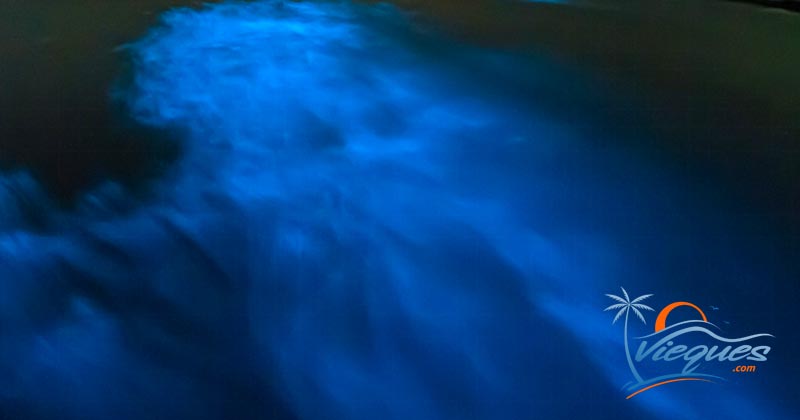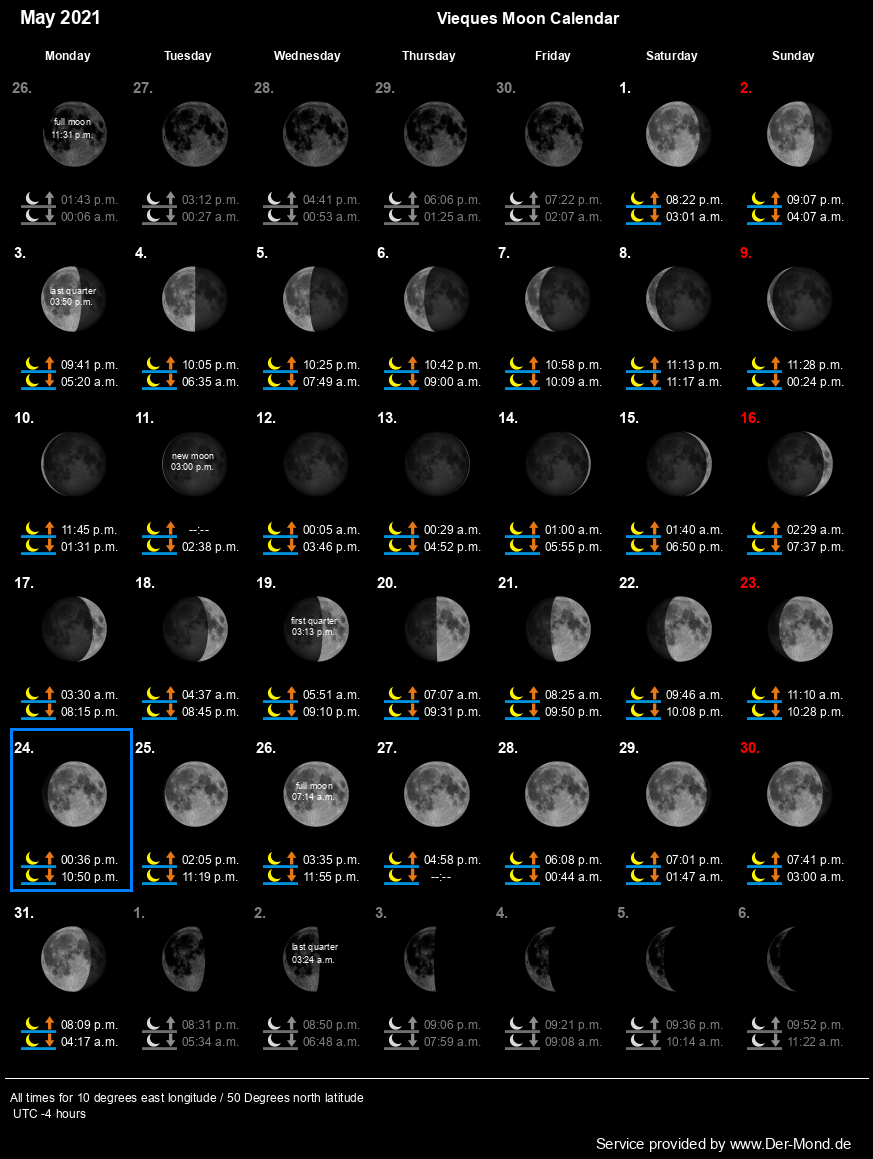Experience the Magic of Mosquito Bay…The Brightest Bioluminescent Bay in the World
Puerto Mosquito (Mosquito Bay) is located on the southern shore of the island of Vieques, one of the islands of Puerto Rico. This bay is often referred to as “magical”, those blessed with the opportunity to experience it always agree. The bioluminescent bay in Vieques was officially declared the brightest in the world by Guinness Book of World Records in 2008. Hurricane Maria caused much destruction on the island, it sadly disrupted the delicate balance of the bay, the beloved Mosquito Bay went dark. To everyone’s surprise the bioluminescent bay not only recovered, but it is also brighter than it ever was in the past.
Don’t leave Isla de Vieques without taking a tour of this magnificent and magical natural wonder. It will be a magical, priceless memory to remember for a lifetime. The bio bay is best experienced during a “New Moon” phase, so we’ve included an interactive moon phase calendar below to help you plan your trip accordingly. In the waters of Mosquito Bay, there are organisms named Pyrodinium bahamense, Dinoflagellates (dinos). These “dinos” are responsible for this amazing natural phenomenon. When the “dinos” come into contact with another organism or shaken they produce a bright burst of blue light.
Bioluminescent Bay Tours
Vieques, Puerto Rico
Bioluminescent Bay Tours – Updated September 2019
Friendly and knowledgeable tour guides await to give you an unforgettable experience at the Bio Bay, you can explore it on a kayak tour or an electrically powered boat.
- Abe’s Snorkeling & Bio Bay Tours – (787) 741-2134 or (939) 224-2095
- Bieque Eco Trips – (787) 922-2701
- Black Beard Sports – (787) 300-0155 or (787) 966-7540
- Blue Waters Caribbean Adventures – (844) 210-2922
- Din Din’s Bio Bay Tours – (787) 448-5931
- Fun Brothers (787) 435-9372 or (787) 741-0151
- JAK Water Sports – (787) 644-7112
- Melaya’s Tours – (787) 222-7055
- Taino Aqua Adventures – (787) 349-6964
- Travesias Isleñas – (787) 447-4104
- Vieques Kayaks – (787) 905-6782
What the World says of Bioluminescent Bay
Vieques, Puerto Rico
"Brightest Bio Bay in the World" by Guinness World Records
Brightest Bio Bay in the World
August 4, 2008 / Guinness Book of World Records 2008 – Living Light
“The Mosquito Bioluminscent Bay on the Island of Vieques, Puerto Rico is the most bioluminescent in the World. It contains up to 160,000 microscopic dinoflagelates per liter of water.
When agitated, these microscopic organisms (Pyrodinium bahamense or swirling fire) reacts emitting a blue-green light for about a decimal of a second. There are other bioluminescent bays around the island, but the Mosquito Bio Bay is the one that shines with the most intensity, its shallow and small entrance from the sea impedes the waves from washing away the dinoflagellates; and the mangrove trees, with their decomposition process, provides abundant food for the micro-organisms.”
One of the most 50 Most Romantic Places on Earth
One of the most 50 Most Romantic Places on Earth
by Travel & Leisure
“Illuminated Vieques A guided tour on a motorboat isn’t the way most romantic evenings begin, but once you slip your body into Mosquito Bay, a bioluminescent lagoon off the island of Vieques, you’ll have forgotten the exhaust fumes. Millions of “stars” (actually, they’re microscopic organisms in the water) light up with a stunning blue-white glow, and scatter with every splash you make. Spielberg couldn’t ask for better special effects.”
Go With the Glow!! Is it Magic? by National Geographic (new window)
No, it’s not magic. With each paddle stroke, the girls stir up millions of tiny dinoflagellates (dy-no-FLAH-juh-luhts). When stirred at night, these plantlike life-forms glow beautifully. Each gallon of Mosquito Bay water holds some 750,000 dinoflagellates. Their combined light creates spectacular evening shows.
On the island of Vieques off the coast of Puerto Rico, Mosquito Bay’s dinoflagellates give off their bioluminescent (by-oh-loo-mih-NESS-ent) light from dusk until dawn. “In other parts of the world, bioluminescence is seasonal,” explains Sharon Grasso, a tour guide on Vieques. “But here, the water glows brightly year-round.”
Each night Grasso shows off the natural beauty of the bay. Passengers stare in awe as the tour boat leaves a glittering trail. They dip their hands in the water, leaving greenish-blue trails of their own.
Mosquito Bay’s displays are threatened, however. Bright artificial light from nearby developments can outshine the natural glow. Pollution, destruction of mangrove trees, dredging, land development, and overuse of the bay’s water can kill the fragile dinoflagellates. “We can’t let the lights go out,” says Grasso. “The magic of Mosquito Bay should live on forever.”
Planning your Visit to the Bio Bay
What you can do to helps us preserve the Bioluminescent Bay
Every one of us can do a little to ensure that our children and the next generations can enjoy this natural wonder.
- Do not swim in the bio bay. It is against the law, responsible tour guides will not allow you to swim. Any chemicals you apply to your skin such as bug repellent, lotions, etc. could cause harm to the delicate balance of the bio bay.
- Only book tours with licensed tour operators. Tour guides that allow you to swim are breaking the law and not showing respect or love for the island. If you’re on a kayak, you can touch the water to see the “starry lights” come to life against your skin.
- Please refrain from throwing any type of objects, food or trash on the water during your tour. The smallest object, can or piece of trash can kill thousands of the precious little “dinos” that create the night show.
Interactive Moon Phase Calendar
Below you can see the current moon phases for this month. To best plan your trip to the bio bay, try to book a tour around new moon phases, when it is darkest at night, so you can maximize your bioluminescent bay experience. Click the calendar image to link the full moon calendar to see what the moon phases will be around your trip dates.
Bioluminescent Bay Videos
Following are a few videos to give you an idea of the phenomenon…but you have to be here to experience it, it is magic! It is truly hard to capture on a camera and to see it first hand is an experience like no other.
Puerto Rico was blessed with 3 bioluminescent bays, the brightest is in Vieques. Commonly known as Mosquito Bay by tourists, its formal is Caño Hondo, commonly known as Puerto Mosquito. The Vieques Bio Bay is the perfect environment for these dinos to thrive and multiply, it is shallow and the mouth of the bay is small, so the bright tiny organisms are trapped and protected in the bay, making it very, very bright. The mangroves surrounding the bay provide the perfect nutrition for the Pyrodinium bahamense. Any changes in the delicate ecosystem can diminish the healthy balance of the bay.
The second brightest is Laguna Grande in Fajardo, and the least bright is in La Parguera in the town of Lajas due to tourist exploitation and poor conservation efforts. If you make it to Porta del Sol (west coast), we do encourage you to visit La Parguera’s Bio Bay, but instead of taking the boat trip, book a kayaking trip, they will take you to spots where boats can reach and the bioluminescence is brighter.

